WACKER’s SILRES® BS 6920 Silane-terminated Binder Provides A Reliable Protection from Stains and Wear for Concrete Floors
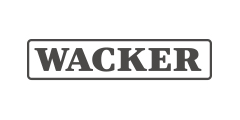



Flawless Every Step of the Way
Concrete floors are chic, but sensitive: Impregnation with SILRES® BS 6920 provides reliable protection from stains and wear, and makes the surface more aesthetically pleasing.

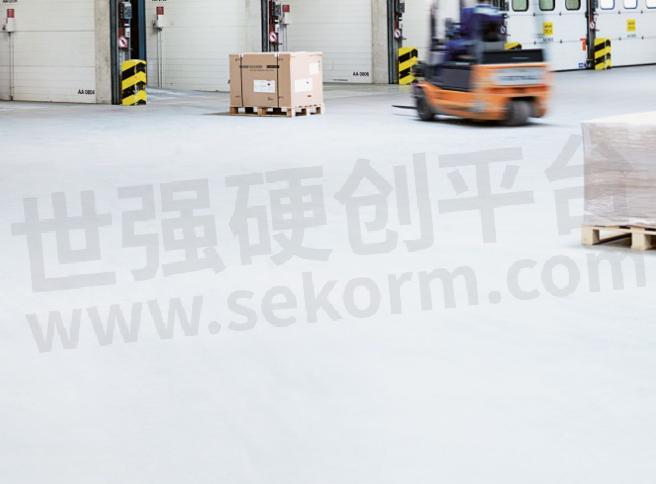
Concrete floors have changed their image in the last 30 years. Though formerly preferred in garages, warehouses and factory halls, they gained a place in modern interior design in the 1980s: high-quality concrete and cement-bound flowing-screed flooring that has been ground and polished is now considered chic. It adorns exhibition and retail areas, shopping arcades, bistros and museums. Even developers of exclusive residential areas have been won over by the unadorned elegance of a concrete flooring in kitchens and living rooms.
A Hard Appearance, but Sensitive Inside
However, concrete flooring and cement-bound screeds and less abrasion resistant than they appear due to their porous surface. When subject to foot or wheel traffic, concrete floors shed material, which is later deposited as dust on nearby objects. When heavily stressed for longer periods, the flooring even becomes fragile. As a result of its porosity, the unprotected surface also absorbs spilled drinks, engine oil or other fluids. The result is ugly marks that cannot be removed.

Protection against Abrasion and Marks
To prevent this, concrete and screed floors are protected against soiling and abrasion. The chemical industry has developed a range of impregnation agents for this purpose. Water-based systems based on silicates and solvent-based impregnating agents that are based on silane are widely used. During impregnation, liquid preparations penetrate deep into the open pores and fill them partially or entirely. Once the agent has solidified, liquid substances cannot soak into the treated surface. It is better if they can simply be wiped off without trace.
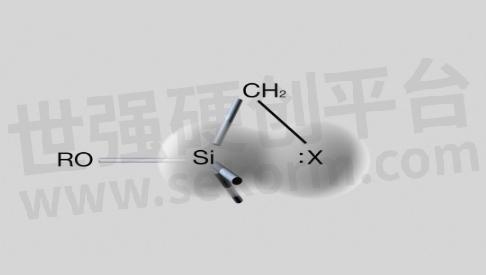
Many Agents Are Pushed to Their Limits
However, day-to-day soils push many impregnation agents to their limits: WACKER chemist Dr. Udo Anders has tested some commercial concrete floor impregnation agents and ascertained that silicate-, and even silane-based agents only provide very limited stain protection in many applications - even for day-to-day soiling materials. What use is an impregnation that cannot deal with ketchup, mustard, red wine or cola? Despite impregnation, it is difficult to remove such stains and keep the floor looking like new. What is more, for toxicological and environmental-protection reasons, the construction industry is striving to avoid solvent-based systems.
The Solution is Protection with Alpha-Silane
Dr. Udo Anders offers the answer with SILRES® BS 6920. The binder for impregnating concrete is based on WACKER’s alpha-silane technology, and combines outstanding soiling resistance with high mechanical strength. As with all silane-terminated polymers, SILRES® BS 6920 is crosslinkable: exposure to moisture triggers the formation of a siloxane network. Due to WACKER’s own alpha-silane technology, all that is needed is the presence of an aminosilane catalyst to ensure that crosslinking proceeds fast enough.
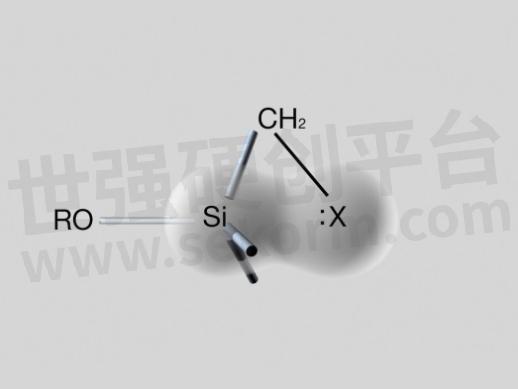
Close-Meshed Network
WACKER developers have custom-designed the new polymer for use in concrete impregnating agents. For example, the silane building blocks were modified so that SILRES® BS 6920 cures to form a particularly close-meshed network of quartz-like structural units. The length of the polyether chains was also adjusted. These optimization measures mean that the viscosity of the new binder is as low as olive oil. The binder penetrates deep into the pores of the concrete floor, fills them and cures to form a hard material. Water- or oil-based fluids can no longer penetrate into the treated floor, and cause a permanent color change even if they are wiped off over the course of the day. The mechanical reinforcement of the substrate increases the abrasion resistance at the same time. If the surface is exposed to high levels of UV radiation, the chemists recommend using the SILRES® BS 6920-based impregnating agent with UV stabilizers.
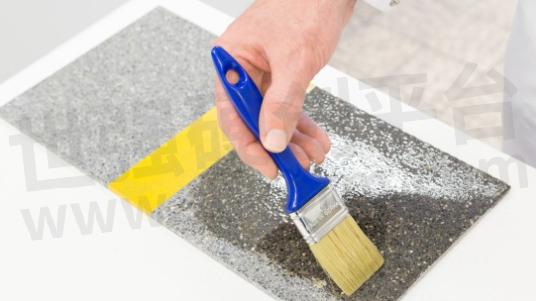
Tests have shown that SILRES® BS 6920 offers substrates effective protection against even stubborn soiling agents. Even after several hours, red wine, coffee, and oil can be wiped off without leaving any stains.
“SILRES® BS 6920 enables the construction industry to easily produce one-component impregnating agents with high scrub resistance for concrete and screed floors.”
Dr. Udo Anders
Diverse Possibilities
“SILRES® BS 6920 makes it possible for the construction industry to easily produce one-component impregnating agents that exhibit high scrub resistance for concrete and screed floors,” says Dr. Udo Anders The binder itself is solvent-free and can also be further processed without additives due to its low viscosity. But it can be diluted with solvents if needed. It is now possible to produce transparent impregnating agents that give concrete floors a glossy and polishable surface finish, even on rough surfaces. However, formulators can also mix in matting agents, pigments or reinforcing fillers and then reduce the viscosity by adding a solvent. In this way, the preparation produces a thin coating with a matt surface.
Easy to apply
It’s also a cinch to apply the impregnation agents: they are one-component and can be applied with a mop or roller, or sprayed on with an airless spray gun. For highly porous and absorbent flooring, it is advisable to apply two coats. With the first coat, the agent soaks into the floor; the second coat reduces the surface roughness by film-forming, with the film typically having a thickness of about 50 to 100 grams per square meter. You can walk on the floor after twenty-four hours and – if required – polish it.

Effective Stain Protection
Yet the most impressive feature is the anti-staining properties achieved by impregnation with SILRES® BS 6920. In his Burghausen lab, Dr. Anders has compared the stain protection of SILRES® BS 6920 on cement-bound test plates with the effect of impregnating agents based on silicates or silanes. The result is clear: in the case of the silicate impregnation, fourteen of the twenty test substances left permanent stains; in the case of silane impregnation, it was seven, and in the case of SILRES® BS 6920, only three.
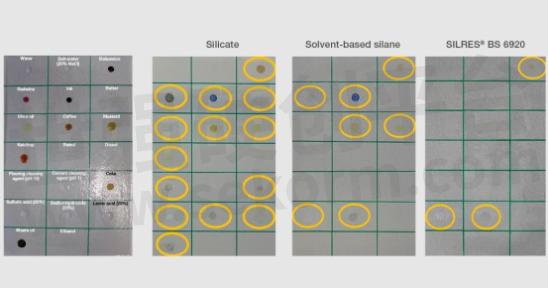
“SILRES® BS 6920 is therefore the binder of choice when dealing with heavy stress from food, tire marks, foot traffic or vehicle traffic and the flooring needs to remain easy to clean,” adds marketing manager Udo Goedecke. The application possibilities of impregnation agents produced with this silane-terminated binder range from parking garages, car repair shops, train stations, and logistics centers, through showrooms, catering facilities, and event and convention centers to museums and residential buildings.
Floor Surface Treatment
Impregnation
Solid, porous materials are
saturated with dissolved,
emulsified or dispersed
substances. The pores are filled
either partially or completely.
Coating
A thin coating is applied to
materials to prevent substances
from entering or escaping. Pores
are not filled, even if there are
several layers.
Concrete Impregnation
According to the EN 1504-2 standard, concrete impregnation is a treatment that partially or totallfills the pores of the concrete. Depending on the absorbency of the concrete and the quantity of the preparation used for the treatment, an ultrathin, non-uniform film also forms on the concrete surface. In comparison, the term coating applies if the treatment agent does not penetrate the pores and – instead of filling the pores – lies on the surface, bonds strongly and forms a sealed, thick film that also covers the pores. The film thickness of a coating is normally between 0.1 and 5.0 millimeters. Impregnations are generally produced using no-solids formulations based on SILRES® BS 6920. Adding solids stops the formulation from penetrating deeply into the pores, producing a thin coating.
WACKER’s alpha-Silane Technology
In the early 2000s, WACKER developed organofunctional alkoxysilanes that could couple to organic polymers and were also characterized by an exceptionally high reactivity to moisture. The reason for the reactivity lies in the structure of these silanes: one of the four binding partners of the silicon atom is a nitrogen-containing organic group, whose nitrogen atom is bound to the silicon atom via a methylene bridge. This short bridge creates precisely the distance needed between the two atoms for the nitrogen atom to facilitate release of the alkoxy groups from the silicon atom, thereby accelerating the reaction with water molecules. Silanes of this type are called alpha-silanes – in contrast to those containing the significantly longer propylene bridge, the so-called gamma-silanes. The reaction-accelerating effect is so great in the alpha-silanes that they react about 100 to 1,000 times faster than the corresponding gamma-silanes.
This high reactivity is not even affected when the alpha-silane is coupled to an organic polymer. For the alpha-silane-terminated polyethers WACKER has already performed the coupling, rendering the polymer crosslinkable: the reaction with moisture produces a siloxane network. However, WACKER also offers alpha-silanes that are not bound to a polymer. At WACKER, “alpha-silane technology” refers to the company’s entire product portfolio of alpha-silanes and alpha-silane-terminated polymers as well as its extensive chemical-technical expertise concerning these compounds.
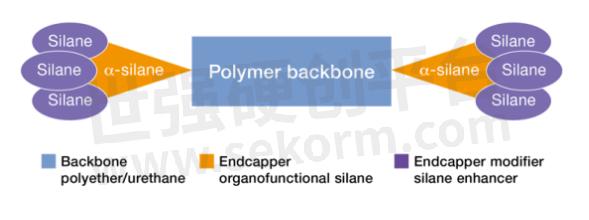
- |
- +1 赞 0
- 收藏
- 评论 0
本文由sr转载自WACKER Official Website,原文标题为:Flawless Every Step of the Way,本站所有转载文章系出于传递更多信息之目的,且明确注明来源,不希望被转载的媒体或个人可与我们联系,我们将立即进行删除处理。
相关推荐
Wacker Offers Effective Solutions for Protecting Concrete from Water
A functioning infrastructure is the key to a society’s prosperity and well-being. But the roads and bridges in prosperous countries are getting old. In the United States, 56,000 bridges are deemed to be structurally deficient; in 2016, roughly 3.8 million square meters of bridges were found to be in urgent need of repair in Germany alone.
Microchips Are Manufactured Using Polysilicon and Specialty Chemicals Made by WACKER
Without polycrystalline silicon, digitalization would be unthinkable. Glossy and silvery in appearance, polysilicon is among the purest man-made materials and the most important raw material required in the semiconductor industry. Today, nearly one in two microchips are manufactured using polysilicon made by WACKER. And by no means is this WACKER’s only contribution to the industry. Apart from polysilicon, process chemicals by WACKER also play a key role – and the demands on purity and quality are high.
WACKER有机硅产品WACKER® RTV-S 691和ELASTOSIL® S 692在太空中的应用
瓦克的有机硅产品自上世纪五十年代初在市场上推出以来已经取得了长足的发展。如今,它不仅影响着全世界数十亿人的日常生活,而且还被用于人造卫星,在距离我们36,000公里的高空绕地球运行。
瓷砖的三大趋势及其对瓷砖胶粘剂的影响
描述- 瓷砖在全球范围内流行,现代瓷砖种类繁多,包括瓷质、玻璃、复合材料和合成材料等,外观多样。瓷砖粘合剂的需求也随之增加,传统粘合剂难以满足现代瓷砖的需求。聚合物改性技术能够提升粘合剂的性能,适应不同瓷砖的粘合需求。新型瓷砖粘合剂不仅提高了施工效率,还降低了材料消耗和碳排放。瓷砖趋势包括自然石材和木纹瓷砖、新型形状和结构、大尺寸瓷砖等,对粘合剂的要求也越来越高。
WACKER Presents Innovative Solutions in Construction and Coatings at PAINTINDIA
At this year’s PAINTINDIA, WACKER will be presenting two dispersible polymer powders for formulating tile adhesives that will soon be introduced into the growing Indian market: VINNAPAS® 4419 E and VINNAPAS® 8819 E. WACKER will also be presenting a binder specifically designed to meet the requirements of barrier coatings for paper: PRIMIS® SAF 9600.
VINNAPAS®8420 T可分散聚合物粉末
描述- VINNAPAS® 8420 T是一种适用于干混砂浆的分散性聚合物粉末,特别适用于瓷砖粘合剂。它基于乙烯基乙酸、乙烯和氯乙烯的柔性共聚物,属于VINNAPAS® T产品系列,提供抗垂效果。此外,它还提供优异的浸水后粘附性。
型号- VINNAPAS® 8420 T
产品概述VINNAPAS®分散体
描述- VINNAPAS® VAE分散体基于乙烯醋酸乙烯共聚物和接枝共聚物,提供优异的性能、安全性和多功能性。该产品具有快速固化和良好的粘附性,适用于多种粘合剂应用,如纸包装、木材、地板安装、汽车内饰和标签等。VINNAPAS®分散体提供高粘附性、耐热性和对多种基材的粘合能力,同时具有耐皂化性和永久性柔韧性。Wacker Chemie AG通过其在全球的实验室和技术中心提供技术支持,帮助粘合剂制造商开发新配方或优化现有产品。
型号- VINNAPAS® EP 11,VINNAPAS® EP 441,VINNAPAS ®,EP 8010,VINNAPAS® AF 875,EP 11,VINNAPAS® EP 401,EAF 67,VINNAPAS® DPN 47,EF 8860,VINNAPAS® EP 400,EP 441,VINNAPAS® DPX 271,EAF 68,EP 17,EP 400,VINNAPAS® H 65,AF 875,VINNAPAS® DP 55,DPN 18,VINNAPAS® EP 8041,VINNAPAS® EF 8860,VINNAPAS® EP 1,DPN 15,DP 55,DPN 16,VINNAPAS® EP 17,EP 1,DP 500,DP 600,EP 8041,VINNAPAS® DP 600,EP 24,VINNAPAS® DPN 18,VINNAPAS® DP 500,VINNAPAS® DPN 15,DPX 271,VINNAPAS® DPN 16,VINNAPAS® EP 8010,DPN 47,EP 401,VINNAPAS®,H 65,VINNAPAS ® VAE,VINNAPAS® EAF 67,VINNAPAS® EAF 68,VINNAPAS® EP 24
WACKER Presents Silicone Materials for Enhancing the Safety of Lithium-Ion Batteries
WACKER will be presenting a selection of silicone products for battery technology and electromobility at this year’s Battery Show Europe. The focus will be on the potting compounds ELASTOSIL® CM 181 and ELASTOSIL® CM 185. Both products boost battery safety in electric vehicles.
VINNAPAS®5129 L可分散聚合物粉末
描述- VINNAPAS® 5129 L 是一种适用于干混砂浆的分散性聚合物粉末,特别适用于自流平地板化合物和砂浆。它基于乙烯乙酸乙烯共聚物硬共聚物,属于 VINNAPAS® L 产品系列,可改善砂浆的平整性和表面性能,以及新鲜砂浆的稳定性。
型号- VINNAPAS® 5129 L
VINNAPAS®5047 T可分散聚合物粉末
描述- VINNAPAS® 5047 T 是一种灵活的分散性聚合物粉末,具有轻微的触变效应和良好的工作性,适用于瓷砖粘合剂、抹灰化合物和ETICS。它基于乙烯醋酸乙烯共聚物,提供触变性能,具有非滑动特性,改进了粘接性、弯曲强度、变形性和耐磨性。
型号- VINNAPAS® 5047 T
电子商城






























































































































































































登录 | 立即注册
提交评论